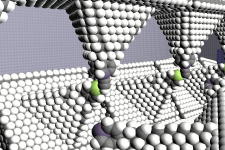Molecular assembler
In molecular nanotechnology assembler is a hypothetical robot in miniature ( nanobot ), the manipulated individual atoms and molecules. This molecular structures could be created that do not occur in nature. The first draft of such a device coined by Eric Drexler in 1986, are presented in his book Engines of Creation, in the assembler as a basis of molecular nanotechnology.
One of the longer term goals of nanotechnology is to produce programmable, self-replicating assembler. These robots could manufacture its own with the proper building plans and with appropriate raw materials and energy supply complete copies. When these copies are further produced and the number of a certain time is increased exponentially, it can be reprogrammed in order to produce a different product. Such a design of an assembler would contain about 1 billion atoms and can place about 1 million atoms per second, so a replication time of 1000 seconds, or slightly more than 16 minutes would result.
The preferred material for an assembler is carbon in its diamond form, since it has superior material properties, and is chemically inert. The same is true for the majority of the products that can be produced with an assembler. It follows that one kilograms could make to assemblers within about 16 minutes and 1 kilograms of another product.
Skepticism about assemblers
While some scientists view these robots as one of the most important technologies of the future, others deny that the production of such a technology is possible. The fraction of the skeptics has shrunk in recent years, even in the face of the growing number of contradictory evidence.
Other concerns arise from the nature of the assembler. In a scenario in which they have their own plans " on board " and are able to replicate themselves, destroy runaway assembler the complete biosphere, to gain energy and raw materials for their self-replication. This scenario is referred to as " gray goo scenario" ( "gray goo " scenario ), since large tracts of the biomass is transformed into " gray goo ". The problem is by outsourcing the design specification deal, since assembler then need to access a central plan, instead of abstaining himself and in the event of an escalation self-replication can be stopped.
On the conditions that would have to be for the "gray goo " scenario fulfilled, we see, however, that this risk is outweighed than the one caused by molecular nanotechnology else.
A completely autonomous, self-replicating assembler would not only be more difficult to develop and less efficient than specialized, but as a direct consequence also economically less interesting. This does not mean that it is physically impossible, but only that there is less incentive to develop such an assembler.
The construction of a so-called " proto- assembler " that acts as the output device is a major expense, since it already thousands atoms would have to be joined together. One possible way to get there is DNA construction.
Biological assembler
Bacteria and other single-celled organisms represent relatively small self-replicating assembler of nature, which are programmed by genes. Biotechnology deals with the use of cells and their products in industrial applications and also includes the " reprogramming " of cells by transformation with foreign and modified genes. The result are genetically modified organisms and recombinant proteins. By methods such as DNA - DNA Origami machines can be produced.









